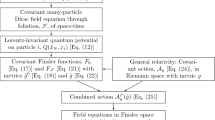Abstract
We discuss quantum fields on Riemannian space-time. A principle of local definiteness is introduced which is needed beyond equations of motion and commutation relations to fix the theory uniquely. It also allows us to formulate local stability. In application to a region with a time-like Killing vector field and horizons it yields the value of the Hawking temperature. The concept of vacuum and particles in a non-stationary metric is treated in the example of the Robertson-Walker metric and some remarks on detectors in non-inertial motion are added.
Similar content being viewed by others
References
Hawking, S.W.: Particle creation by black holes. Commun. Math. Phys.43, 199 (1975)
Unruh, W.G.: Notes on black-hole evaporation. Phys. Rev. D14, 870 (1976); compare also: Davies, P.C.W.: Scalar particle production in Schwarzschild and Rindler metrics. J. Phys. A8, 609 (1975)
Fulling, S.A.: Nonuniqueness of canonical field quantization in Riemannian space-time. Phys. Rev. D7, 2850 (1973)
Haag, R., Kastler, D.: Algebraic approach to quantum field theory. J. Math. Phys.5, 848 (1964)
Kastler, D.: Topics in the algebraic approach to quantum field theory, Cargèse lectures 1965, Lurçat, F. (ed.). N.Y.: Gordon and Breach 1967
Rindler, W.: Kruskal space and the uniformly accelerated frame. Am. J. Phys.34, 1174 (1966)
Bisognano, J.J., Wichmann, E.H.: On the duality condition for a Hermitian scalar field. J. Math. Phys.16, 985 (1975); On the duality condition for quantum fields. J. Math. Phys.17, 303 (1976)
Reeh, H., Schlieder, S.: Bemerkungen zur Unitäräquivalenz von Lorentzinvarianten Feldern. Nuovo Cimento22, 1051 (1961)
Takesaki, M.: Tomita's theory of modular Hilbert-algebras. Berlin, Heidelberg, New York: Springer 1970
Haag, R., Hugenholz, N.M., Winnink, M.: On the equilibrium states in quantum statistical mechanics. Commun. Math. Phys.5, 215 (1967)
Sewell, G.L.: Relativity of temperature and the Hawking effect. Phys. Lett.79A, 23 (1980)
Sewell, G.L.: Quantum fields on manifolds. Ann. Phys. (USA)141, 201 (1982)
Wald, R.M.: On particle creation by black holes. Commun. Math. Phys.45, 9 (1975)
Dimock, D., Kay, B.S.: Classical and quantum scattering on stars and black holes. IAMP-Conference, Boulder 1983
Magnus, W., Oberhettinger, F.: Formeln und Sätze für die speziellen Funktionen der mathematischen Physik. Berlin: Springer 1943
H. Bateman Manuscript Project: Tables of Integral Transforms, Vol. II. California Institute of Technology. Erdélyi, A. (ed.). New York: McGraw-Hill 1954
Author information
Authors and Affiliations
Additional information
Communicated by R. Haag
Rights and permissions
About this article
Cite this article
Haag, R., Narnhofer, H. & Stein, U. On quantum field theory in gravitational background. Commun.Math. Phys. 94, 219–238 (1984). https://doi.org/10.1007/BF01209302
Received:
Issue Date:
DOI: https://doi.org/10.1007/BF01209302




